All-Solution-Processed Quantum Dot Light-Emitting Diode Using Phosphomolybdic Acid as Hole Injection Layer
Abstract
:1. Introduction
2. Materials and Methods
2.1. Materials
2.2. QD-EL Device Fabrication
2.3. Hole-Only Device Fabrication
2.4. Thin Film and Device Characterization
3. Results and Discussion
3.1. Thin-Film Characteristics of PMA
3.2. Device Performance Using PMA as HIL
3.2.1. Electrical Characteristics of Hole-Only Device Using PMA as HIL
3.2.2. Characteristics of QD-EL Device Using PMA as HIL
4. Conclusions
Author Contributions
Funding
Institutional Review Board Statement
Informed Consent Statement
Data Availability Statement
Conflicts of Interest
References
- Colvin, V.L.; Schlamp, M.C.; Alivisatos, A.P. Light-emitting diodes made from cadmium selenide nanocrystals and a semiconducting polymer. Nature 1994, 370, 354–357. [Google Scholar] [CrossRef]
- Coe, S.; Woo, W.-K.; Bawendi, M.; Bulović, V. Electroluminescence from Single Monolayers of Nanocrystals in Molecular Organic Devices. Nature 2002, 420, 800–803. [Google Scholar] [CrossRef] [PubMed]
- Shirasaki, Y.; Supran, G.J.; Bawendi, M.G.; Bulović, V. Emergence of colloidal quantum-dot light-emitting technologies. Nat. Photonics 2013, 7, 13–23. [Google Scholar] [CrossRef]
- Zhang, Z.; Ye, Y.; Pu, C.; Deng, Y.; Dai, X.; Chen, X.; Chen, D.; Zheng, X.; Gao, Y.; Fang, W.; et al. High-Performance, Solution-Processed, and Insulating-Layer-Free Light-Emitting Diodes Based on Colloidal Quantum Dots. Adv. Mater. 2018, 30, 1801387. [Google Scholar] [CrossRef]
- Lin, Q.; Wang, L.; Li, Z.; Shen, H.; Guo, L.; Kuang, Y.; Wang, H.; Li, L.S. Nonblinking Quantum-Dot-Based Blue Light-Emitting Diodes with High Efficiency and a Balanced Charge-Injection Process. ACS Photonics 2018, 5, 939–946. [Google Scholar] [CrossRef]
- Shen, H.; Gao, Q.; Zhang, Y.; Lin, Y.; Lin, Q.; Li, Z.; Chen, L.; Zeng, Z.; Li, X.; Jia, Y.; et al. Visible quantum dot light-emitting diodes with simultaneous high brightness and efficiency. Nat. Photonics 2019, 13, 192–197. [Google Scholar] [CrossRef]
- Lee, T.; Kim, B.J.; Lee, H.; Hahm, D.; Bea, W.K.; Lim, J.; Kwak, J. Bright and Stable Quantum Dot Light-Emitting Diodes. Adv. Mater. 2021, 34, 2106276. [Google Scholar] [CrossRef]
- Palomaki, P.; Twietmeyer, K. 26-3: Optical Modeling of Quantum Dot-OLED (QD-OLED) Color Conversion. SID Symp. Dig. Tech. Pap. 2022, 53, 303–306. [Google Scholar] [CrossRef]
- Chen, H.; He, J.; Wu, S.-T. Recent Advances on Quantum-Dot-Enhanced Liquid-Crystal Displays. IEEE J. Sel. Top. Quantum Electron. 2017, 23, 1900611. [Google Scholar] [CrossRef]
- Hu, Z.; Yin, Y.; Ali, M.U.; Peng, W.; Zhang, S.; Li, D.; Zou, T.; Li, Y.; Jiao, S.; Chen, S.; et al. Inkjet printed uniform quantum dots as color conversion layers for full-color OLED displays. Nanoscale 2020, 12, 2103–2110. [Google Scholar] [CrossRef]
- Dai, X.; Zhang, Z.; Jin, Y.; Niu, Y.; Cao, H.; Liang, X.; Chen, L.; Wang, J.; Peng, X. Solution-Processed, High-Performance Light-Emitting Diodes Based on Quantum Dots. Nature 2014, 515, 96–99. [Google Scholar] [CrossRef] [PubMed]
- Won, Y.-H.; Cho, O.; Kim, T.; Chung, D.-Y.; Kim, T.; Chung, H.; Jang, H.; Lee, J.; Kim, D.; Jang, E. Highly efficient and stable InP/ZnSe/ZnS quantum dot light-emitting diodes. Nature 2019, 575, 634–638. [Google Scholar] [CrossRef] [PubMed]
- Kim, T.; Kim, K.-H.; Kim, S.; Choi, S.-M.; Jang, H.; Seo, H.-K.; Lee, H.; Chung, D.-Y.; Jang, E. Efficient and stable blue quantum dot light-emitting diode. Nature 2020, 586, 385–389. [Google Scholar] [CrossRef] [PubMed]
- Shen, P.; Cao, F.; Wang, H.; Wei, B.; Wang, F.; Sun, X.W.; Yang, X. Solution-Processed Double-Junction Quantum-Dot Light-Emitting Diodes with an EQE of Over 40%. ACS Appl. Mater. Interfaces 2019, 11, 1065–1070. [Google Scholar] [CrossRef] [PubMed]
- Shi, L.; Chen, S. Over 32.5% Efficient Top-Emitting Quantum-Dot LEDs with Angular-Independent Emission. ACS Appl. Mater. Interfaces 2022, 14, 300039–300045. [Google Scholar] [CrossRef]
- Cameron, J.; Skabara, P.J. The damaging effects of the acidity in PEDOT:PSS on semiconductor device performance and solutions based on non-acidic alternatives. Mater. Horiz. 2020, 7, 1759–1772. [Google Scholar] [CrossRef]
- Soultati, A.; Douvas, A.M.; Georgiadou, D.G.; Palilis, L.C.; Bein, T.; Feckl, J.M.; Gardelis, S.; Fakis, M.; Kennou, S.; Falaras, P.; et al. Solution-Processed Hydrogen Molybdenum Bronzes as Highly Conductive Anode Interlayers in Efficient Organic Photovoltaics. Adv. Energy Mater. 2014, 4, 1300896. [Google Scholar] [CrossRef]
- Meyer, J.; Khalandovsky, R.; Gorrn, P.; Kahn, A. MoO3 Films Spin-Coated from a Nanoparticle Suspension for Efficient Hole-Injection in Organic Electronics. Adv. Mater. 2011, 23, 70–73. [Google Scholar] [CrossRef]
- Zhang, Y.; Wang, S.; Chen, L.; Fang, Y.; Shen, H.; Du, Z. Solution-processed quantum dot light-emitting diodes based on NiO nanocrystals hole injection layer. Org. Electron. 2017, 44, 189–197. [Google Scholar] [CrossRef]
- Zilberberg, K.; Gharbi, H.; Behrendt, A.; Trost, S.; Riedl, T. Low-Temperature, Solution-Processed MoOx for Efficient and Stable Organic Solar Cells. ACS Appl. Mater. Interfaces 2012, 4, 1164–1168. [Google Scholar] [CrossRef]
- Jasieniak, J.J.; Seifter, J.; Jo, J.; Mates, T.; Heeger, A.J. A Solution-Processed MoOx Anode Interlayer for Use within Organic Photovoltaic Devices. Adv. Funct. Mater. 2012, 22, 2594–2605. [Google Scholar] [CrossRef]
- Ding, T.; Yang, X.; Bai, L.; Zhao, Y.; Fong, K.E.; Wang, N.; Demir, H.V.; Sun, X.W. Colloidal quantumdot LEDs with a solution-processed copper oxide (CuO) hole injection layer. Org. Electron. 2015, 26, 245–250. [Google Scholar] [CrossRef]
- Wang, Z.; Luo, Z.; Zhao, C.; Guo, C.; Wang, Y.; Wang, F.; Bian, X.; Alsaedi, A.; Hayat, T.; Tan, Z. Efficient and Stable Pure Green All-Inorganic Perovskite CsPbBr3 Light-Emitting Diodes with a Solution-Processed NiOx Interlayer. J. Phys. Chem. C 2017, 121, 28132–28138. [Google Scholar] [CrossRef]
- Lin, J.; Dai, X.; Liang, X.; Chen, D.; Zheng, X.; Li, Y.; Deng, W.; Du, H.; Ye, Y.; Chen, D.; et al. High-Performance Quantum-Dot Light-Emitting Diodes Using NiOx Hole-Injection Layers with a High and Stable Work Function. Adv. Funct. Mater. 2020, 30, 1907265. [Google Scholar] [CrossRef]
- Zhang, H.; Wang, S.; Sun, X.; Chen, S. Solution-processed vanadium oxide as an efficient hole injection layer for quantum-dot light-emitting diodes. J. Mater. Chem. C 2017, 5, 817–823. [Google Scholar] [CrossRef]
- Yi, C.; Zhu, W.; Chen, R.; Huang, L.; Ding, K.; Li, J. Work function tunning of lithium-doped vanadium oxide for functioning as hole injection layer in organic light-emitting diodes. Opt. Mater. 2021, 122 Pt B, 111674. [Google Scholar] [CrossRef]
- Nagar, M.R.; Yadav, R.A.K.; Dubey, D.K.; Jou, J.-H. Solution Process Feasible Highly Efficient Organic Light Emitting Diode with Hybrid Metal Oxide Based Hole Injection/Transport Layer. MRS Adv. 2019, 4, 1801–1809. [Google Scholar] [CrossRef]
- Wu, Q.; Cao, F.; Kong, L.; Yang, X. Solvent-Regulated Electronic Structure and Morphology of Inorganic Hole Injection Layers for Efficient Quantum Dot Light-Emitting Diodes. Adv. Photonics Res. 2021, 2, 2000124. [Google Scholar] [CrossRef]
- Zhu, Y.; Yuan, Z.; Cui, W.; Wu, Z.; Sun, Q.; Wang, S.; Kang, Z.; Sun, B. A Cost-Effective Commercial Soluble Oxide Cluster for Highly Efficient and Stable Organic Solar Cells. J. Mater. Chem. A. 2014, 2, 1436–1442. [Google Scholar] [CrossRef]
- Pu, Y.-J.; Chiba, T.; Ideta, K.; Takahashi, S.; Aizawa, N.; Hikichi, T.; Kido, J. Fabrication of Organic Light-Emitting Devices Comprising Stacked Light-Emitting Units by Solution-Based Processes. Adv. Mater. 2015, 27, 1327–1332. [Google Scholar] [CrossRef]
- Ohisa, S.; Kagami, S.; Pu, Y.-J.; Chiba, T.; Kido, J. A Solution-Processed Heteropoly Acid Containing MoO3 Units as a Hole-Injection Material for Highly Stable Organic Light-Emitting Devices. ACS Appl. Mater. Interfaces 2016, 8, 20946–20954. [Google Scholar] [CrossRef] [PubMed]
- Dong, D.; Lian, L.; Wang, H.; He, G. An efficient solution-processed hole injection layer with phosphomolybdic acid in quantum dot light-emitting diodes. Org. Electron. 2018, 62, 320–326. [Google Scholar] [CrossRef]
- Liu, Y.; Jiang, C.; Song, C.; Wang, J.; Mu, L.; He, Z.; Zhong, Z.; Cun, Y.; Mai, C.; Wang, J.; et al. Highly Efficient All-Solution Processed Inverted Quantum Dots Based Light Emitting Diodes. ACS Nano 2018, 12, 1564–1570. [Google Scholar] [CrossRef] [PubMed]
- Borg, L.Z.; Lee, D.; Lim, J.; Bea, W.K.; Park, M.; Lee, S.; Lee, C.; Char, K.; Zentel, R. The effect of band gap alignment on the hole transport from semiconducting block copolymers to quantum dots. J. Mater. Chem. C 2013, 1, 1722. [Google Scholar] [CrossRef]
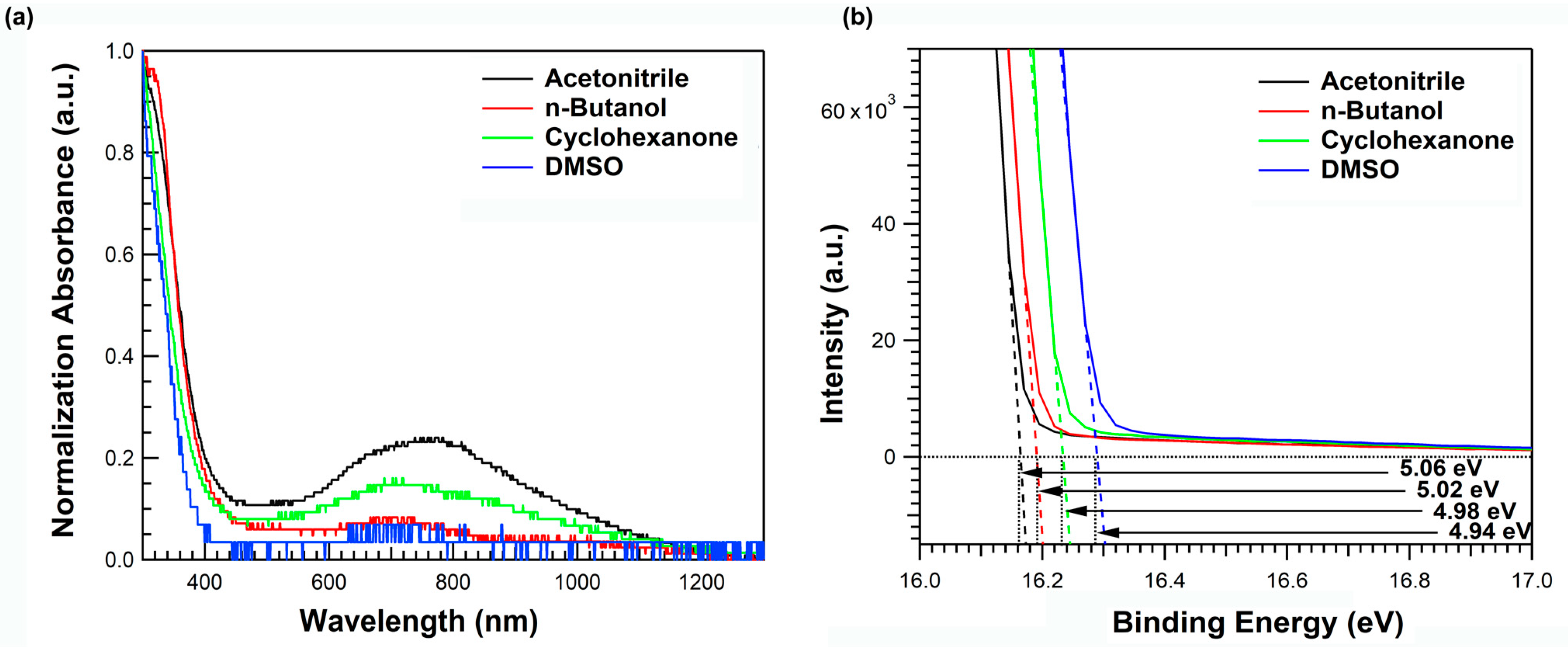


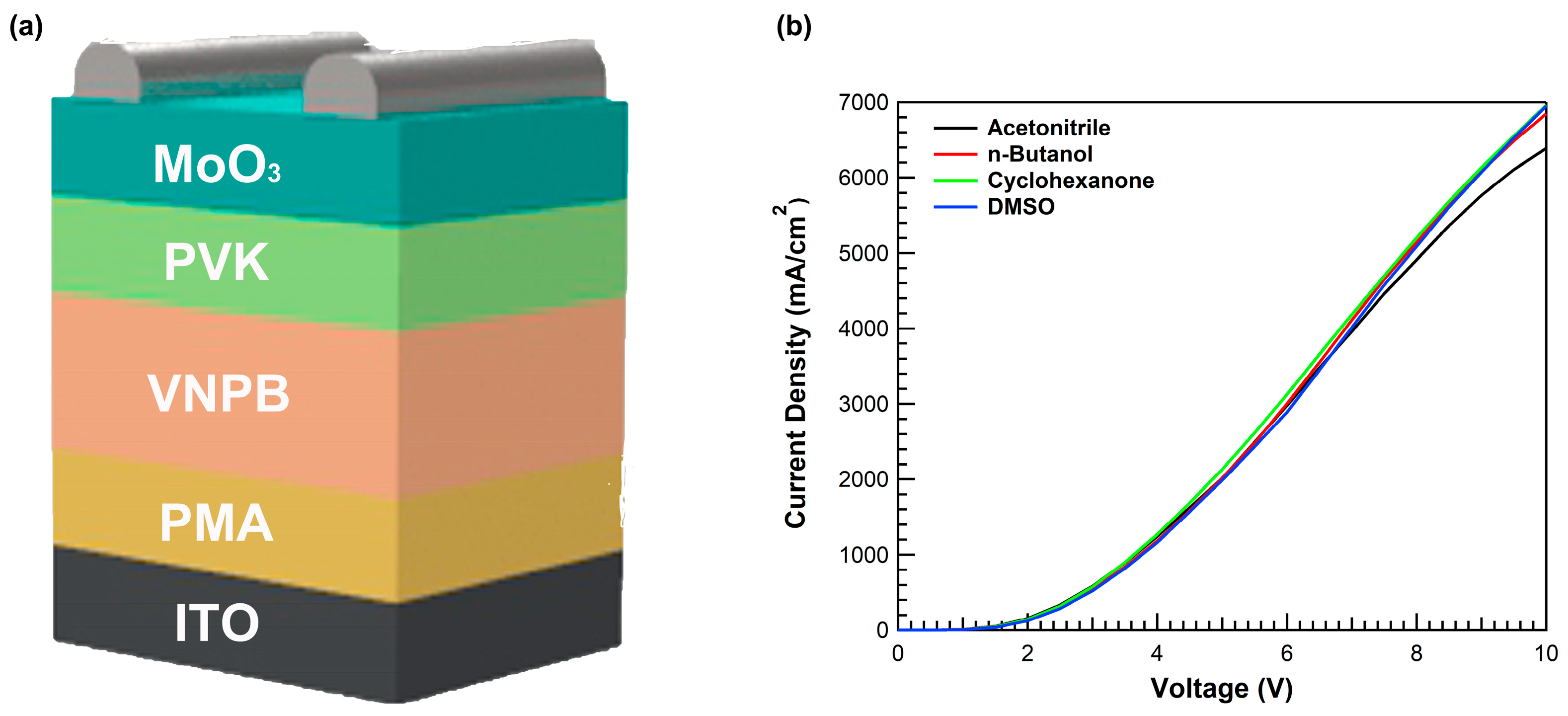
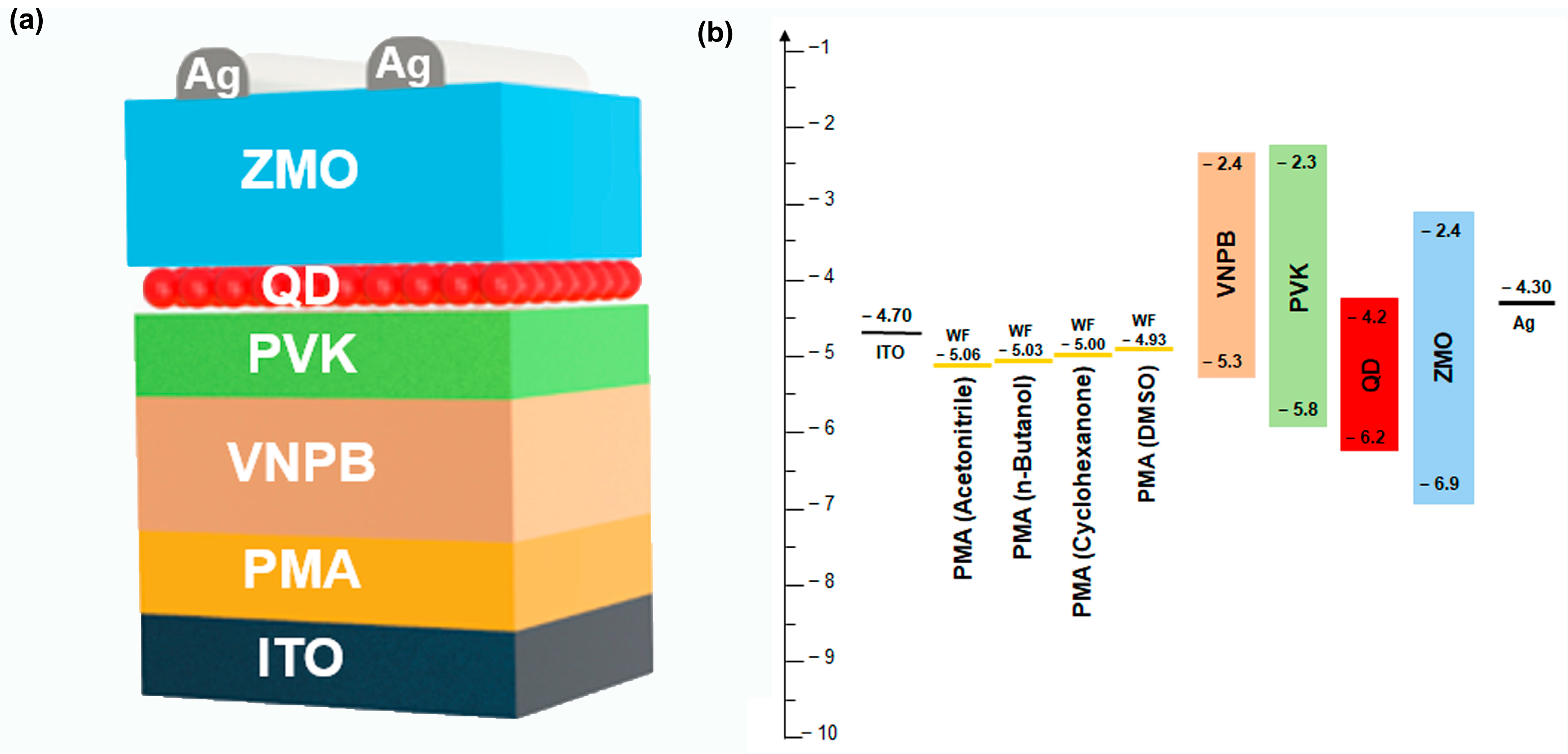
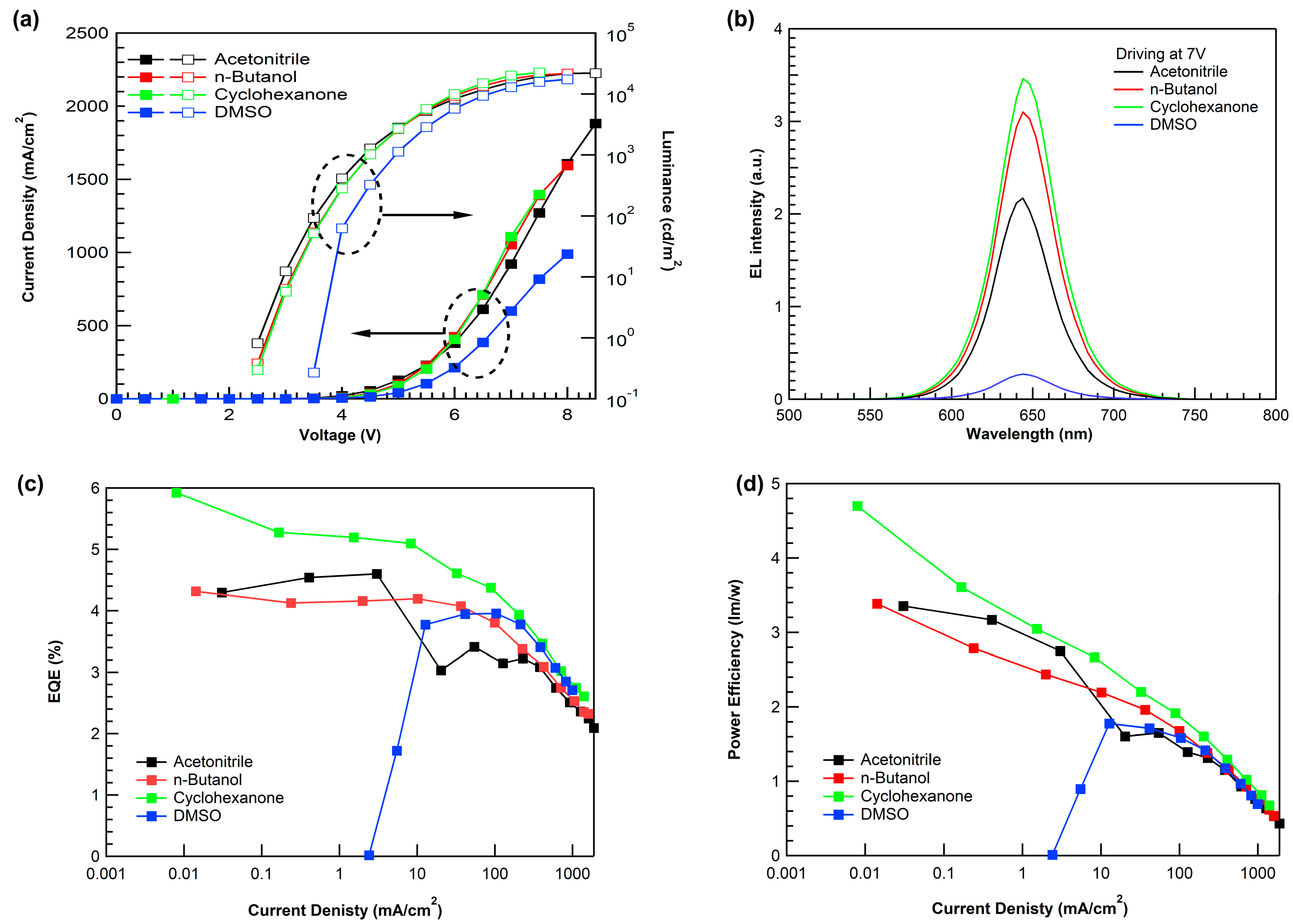
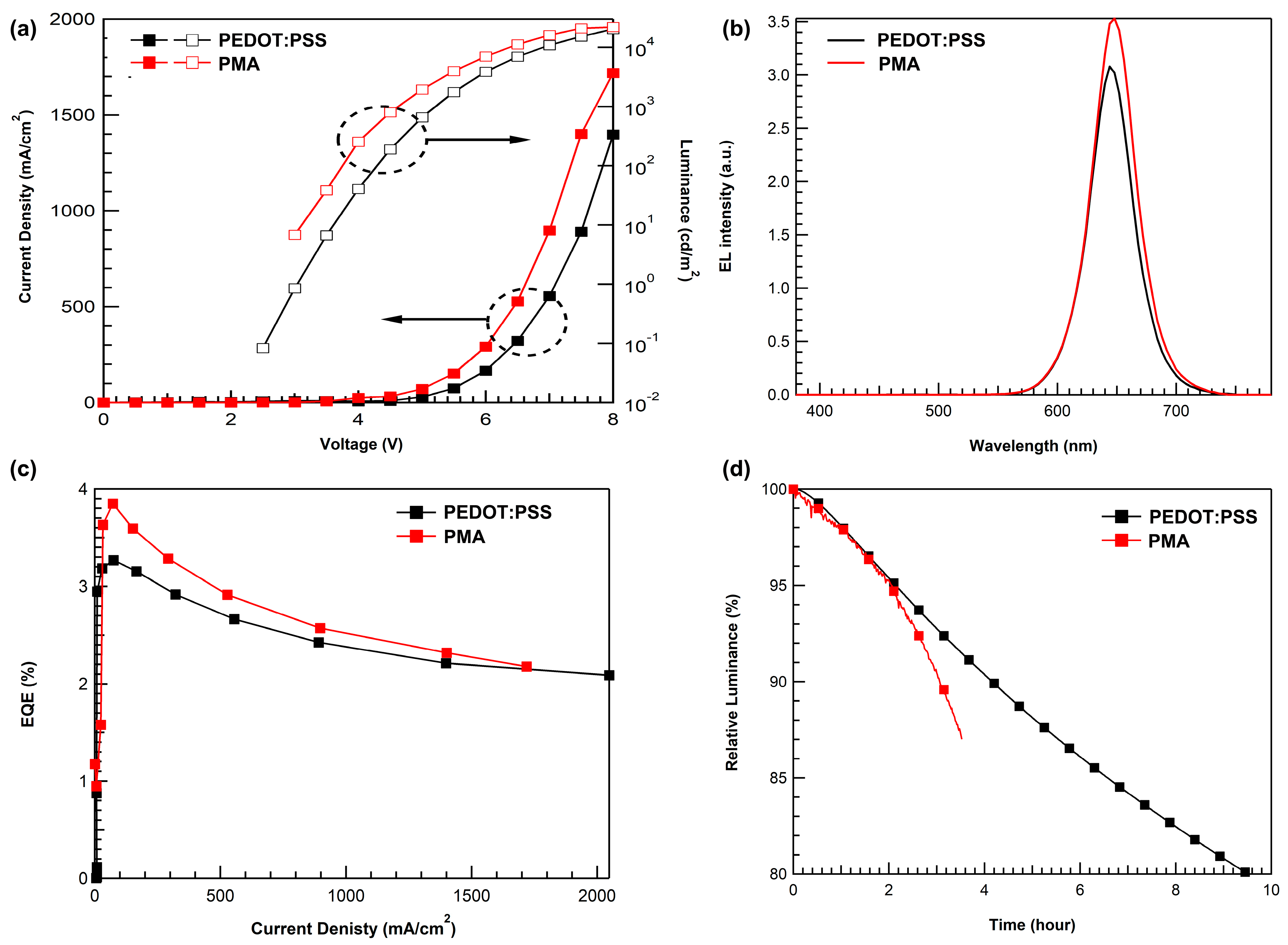
| Solvent | Boiling Point (°C) | Viscosity (cP) | Surface Tension (dynes/cm) |
|---|---|---|---|
| Acetonitrile | 82.1 | 0.33 (25 °C) | 29.29 |
| n-Butanol | 117.7 | 2.54 (25 °C) | 24.57 |
| Cyclohexanone | 155.6 | 2.02 (25 °C) | 34 |
| DMSO | 189 | 2.0 (25 °C) | 43.53 |
| Solvent | Von at 1 nit (V) | Lmax (cd/m2) | EQEmax (%) | PEmax (lm/W) |
|---|---|---|---|---|
| Acetonitrile | 2.5 | 22,050 | 4.59 | 3.35 |
| n-Butanol | 2.6 | 21,700 | 4.19 | 3.38 |
| Cyclohexanone | 2.7 | 22,540 | 5.92 | 4.69 |
| DMSO | 3.6 | 17,470 | 3.95 | 1.77 |
| HIL | Von at 1 nit (V) | L (cd/m2) at 8 V | EQEmax (%) | PEmax (lm/W) |
|---|---|---|---|---|
| PEDOT:PSS | 2.9 | 20,390 | 3.26 | 1.41 |
| PMA (cyclohexanone) | 2.7 | 22,000 | 3.80 | 1.74 |
Disclaimer/Publisher’s Note: The statements, opinions and data contained in all publications are solely those of the individual author(s) and contributor(s) and not of MDPI and/or the editor(s). MDPI and/or the editor(s) disclaim responsibility for any injury to people or property resulting from any ideas, methods, instructions or products referred to in the content. |
© 2023 by the authors. Licensee MDPI, Basel, Switzerland. This article is an open access article distributed under the terms and conditions of the Creative Commons Attribution (CC BY) license (https://creativecommons.org/licenses/by/4.0/).
Share and Cite
Hwang, J.H.; Seo, E.; Park, S.; Lee, K.; Kim, D.H.; Lee, S.H.; Kwon, Y.W.; Roh, J.; Lim, J.; Lee, D. All-Solution-Processed Quantum Dot Light-Emitting Diode Using Phosphomolybdic Acid as Hole Injection Layer. Materials 2023, 16, 1371. https://doi.org/10.3390/ma16041371
Hwang JH, Seo E, Park S, Lee K, Kim DH, Lee SH, Kwon YW, Roh J, Lim J, Lee D. All-Solution-Processed Quantum Dot Light-Emitting Diode Using Phosphomolybdic Acid as Hole Injection Layer. Materials. 2023; 16(4):1371. https://doi.org/10.3390/ma16041371
Chicago/Turabian StyleHwang, Jeong Ha, Eunyong Seo, Sangwook Park, Kyungjae Lee, Dong Hyun Kim, Seok Hyoung Lee, Yong Woo Kwon, Jeongkyun Roh, Jaehoon Lim, and Donggu Lee. 2023. "All-Solution-Processed Quantum Dot Light-Emitting Diode Using Phosphomolybdic Acid as Hole Injection Layer" Materials 16, no. 4: 1371. https://doi.org/10.3390/ma16041371
APA StyleHwang, J. H., Seo, E., Park, S., Lee, K., Kim, D. H., Lee, S. H., Kwon, Y. W., Roh, J., Lim, J., & Lee, D. (2023). All-Solution-Processed Quantum Dot Light-Emitting Diode Using Phosphomolybdic Acid as Hole Injection Layer. Materials, 16(4), 1371. https://doi.org/10.3390/ma16041371







